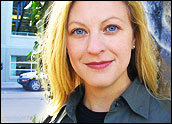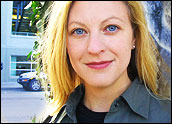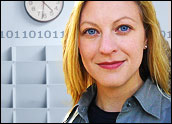
More than 200 scientists and longevity activists gathered at UCLA recently to discuss advancements in repairing humans. New technology is making it possible to imagine a world with ever greater life spans, but old world issues pervaded the discussions.
The Methuselah Foundation’s Aubrey de Grey organized the event and kicked it off with a theoretical explanation of how human aging might be reversed in the future. He argues that there are seven kinds of damage in human cells, and his mission is to get scientists all over the world involved in creating the fixes. The reason to focus on aging is not some vain plan to look years younger. Instead, it turns out that aging is a significant risk factor in all the major diseases that the American population faces such as cancer, heart disease, Alzheimer’s and Type 2 diabetes.
The opening panel featured well-known and respected scientists such as Berkeley professor Bruce Ames, father of the Ames test for carcinogens, and professor William Haseltine, who coined the term “regenerative medicine.” However, instead of talking medicine, the discussion focused on one of the oldest complaints in science: how to get money for funding.
Lack of Funding
“We should mount a war on aging where it is not a disease, it is THE disease,” said Gregory Stock, Ph.D., director of the UCLA Program on Medicine, Technology and Society. To do this, Stock proposed an “aggressive publicly funded program.” While no one challenged this idea on the panel, during the two days of the conference, it was clear that some questioned the efficacy of such a plan.
Indeed, in a less formal setting, Ames lamented the fact that under the mostly government-run system of science grants, the “true visionaries are not getting funding.” This is not surprising, given that government agencies are by nature political, making decisions with an eye toward public opinion, not necessarily the best and brightest ideas. Agencies like the U.S. National Institutes of Health and particularly the Food and Drug Administration typically become risk averse over time, as it’s easier to deny approval for an idea or product that no one ever finds out about than it is to take a chance on a revolutionary idea and have it flop.
Yet although government funding agencies can make many mistakes, such as “wasting money on buildings,” as Stock pointed out in discussing California’s Proposition 71 (the stem cell initiative), there still seems to be an allure.
Taxpayer dollars earmarked for aging research would be useful in part because they help “bring legitimacy” to the field, which is sometimes tainted by snake oil salesmen, noted Todd Huffman, a technology entrepreneur who receives funding from government agencies. Official bureaucrat endorsement might help on the legitimacy front, but not everyone thought money was the issue.
“I don’t think there is a shortage of funds — it’s a shortage of ideas,” said Chris Heward, Ph.D., president of the Kronos Science Laboratory, which was started by billionaire John Sperling.
Heward, who studies biomarkers of human aging, is a pessimist when it comes to finding cures. “We don’t even have the means to measure aging,” he lamented. “And even if we cured cancer, we would only expand life expectancy by two years.” However, few of the participants were concerned with such details, particularly when current discoveries show such great promise.
Cancer-Fighting Cells
Two of the most impressive presentations at the conference involved innovative new techniques to fight cancer and heart disease. Researchers led by Zheng Cui, Ph.D., at Wake Forest University discovered a mouse that is naturally resistant to cancer because of special immune cells. They injected these cells into regular mice suffering from tumors and demonstrated a new way to eradicate cancer. Some humans have these same cancer-fighting cells, and now the FDA has approved Cui’s team to conduct human trials. They are currently looking for volunteers for their tests.
Doris Taylor, Ph.D., director of the University of Minnesota’s Center for Cardiovascular Repair gave a similarly awe-inspiring presentation. By harnessing the body’s own ability to regenerate, her team created a beating heart in the lab by injecting stem cells into a nonliving heart matrix. Someday, this technique may be used to replace the hearts of the 5 million Americans struggling with heart failure.
In all, the Methuselah Foundation’s first U.S.-based conference demonstrated that, with and without government funding, researchers dedicated to finding solutions to humanity’s oldest problem — aging — are marching ahead. More private funding, like John Sperling’s initiative or the millions pledged by Clarium Capital’s Peter Thiel (a sponsor of the conference), would be a better and less politically constrained way to fund additional research. Such radical thinking should be on the next agenda.
Sonia Arrison, a TechNewsWorld columnist, is senior fellow in technology studies at the California-based Pacific Research Institute.






















































Molecular biology is now expanding at an explosive pace. What would happen if we were to push the rate of progress just that little bit more?
Meet the real life alliance of engineers, scientists, philanthropists and volunteer fund raisers all of whom have but one thing in common. None of whom want to have an appointment with the grave or the furnace several decades from as of today.
De Grey is a man with a mission. Consider this improbable scenario: a hitherto unknown Cambridge scientist realises he holds the key to saving the lives of countless millions. What is he to do? In that situation what would YOU do? This is not some improbable science-fiction scenario. This is here and right now.
I for one do not want to die.
The Race is ON
"What’s likely to happen within the next 20 to 25, 30 years, we will develop technology that will buy a bit of time. We will develop rejuvenation technology that can be applied to people that are already middle-age and keep them middle-age, or less so to speak, for another 20 or 30 years. During that 20 or 30 years, the technology will be further advanced to give them another, let’s say, 15 years, and so on."
-Aubrey de Grey: Chief Science Officer. Methuselah Foundation
Let’s Roll !